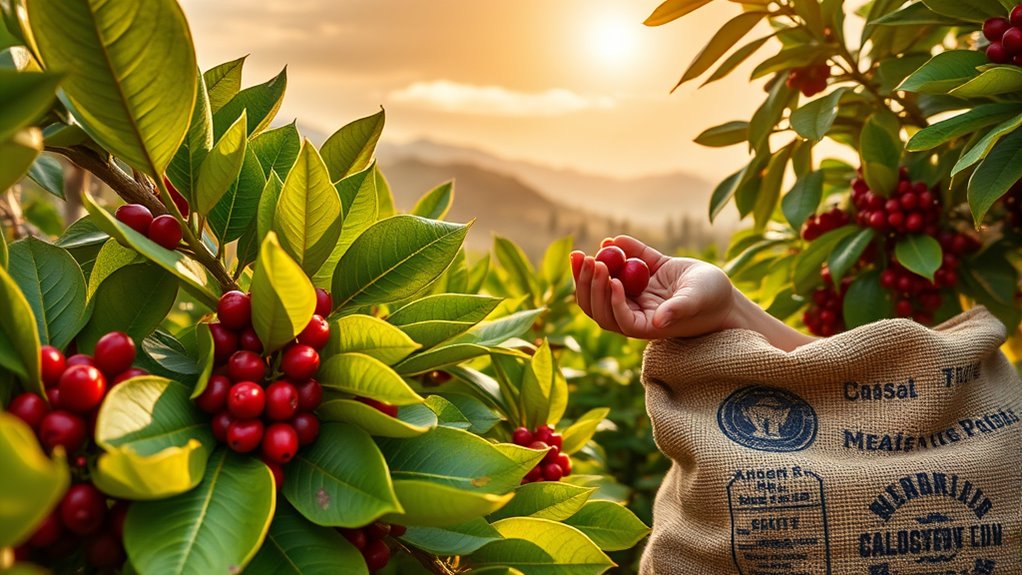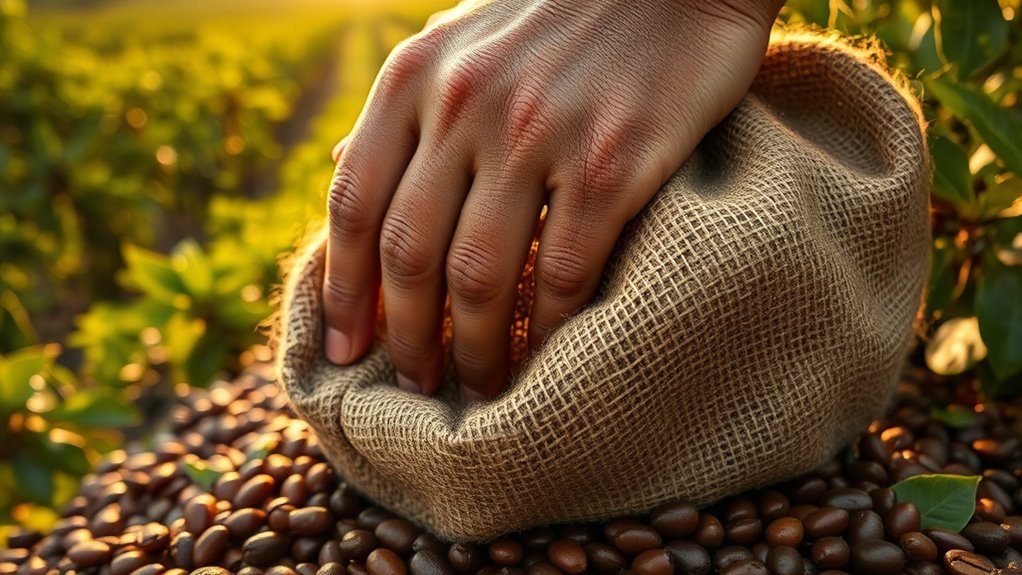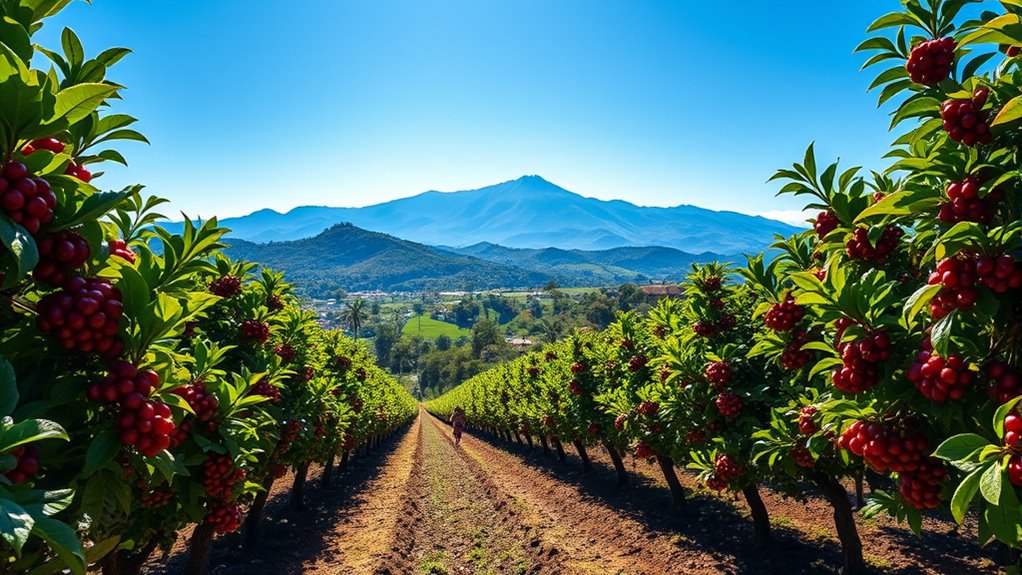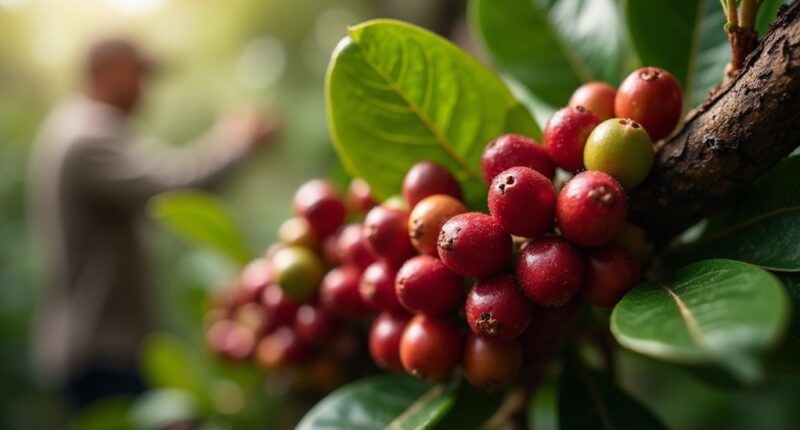So, you wanna know what coffee’s all about? Well, it comes from coffee cherries that grow on trees mainly in tropical areas. These little gems started their journey in Ethiopia when a goatherd named Kaldi noticed his goats dancing after munching on the berries. From there, coffee spread all over the world, making its way into our cozy cafes and homes. And honestly, it’s more than just a drink; stick around, and you’ll find out why!
At a Glance
- Coffee is derived from the berries of the Coffea plant, primarily cultivated in tropical climates.
- The journey of coffee began in Ethiopia, where it was discovered by a goatherd named Kaldi.
- Coffee was historically brewed by Sufi monks in Yemen for enhanced focus during prayers.
- The two main types of coffee beans are arabica, known for its flavor, and robusta, which is stronger in taste.
- Major coffee-producing countries include Brazil, Vietnam, Colombia, Indonesia, and Ethiopia, each contributing unique flavors to the market.
Origin and History of Coffee

Did you know that coffee has a pretty wild backstory? It all kicks off in Ethiopia, where an adventurous goatherd named Kaldi discovered the energizing effects of coffee berries.
Legend has it, he noticed his goats bouncing around after munching on them! Soon, Sufi monks in Yemen started brewing coffee during their rituals to stay focused during long prayers.
Talk about a caffeine boost! From there, coffee spread across the Arabian Peninsula, becoming a beloved drink. Today, coffee is enjoyed worldwide, with Colombian coffee beans being renowned for their distinct flavor profiles and high quality.
The Journey of Coffee Across the World
As coffee made its way across the globe, it transformed from a simple berry in Ethiopia to a beloved beverage enjoyed by millions. You’d be amazed at how coffee cultivation and processing developed in various regions. Brazil leads the pack, while Vietnam is the robusta king. Colombia, despite recent challenges, still shines with arabica. In fact, many of the finest Starbucks coffee beans are sourced from these key coffee-producing regions. Check out the journey:
| Region | Production (Million Bags) | Key Notes |
|---|---|---|
| Brazil | 65 | Global leader |
| Vietnam | 31 | Largest robusta producer |
| Colombia | 11.6 | Facing tough conditions |
Each cup tells a global story!
Cultural Significance of Coffee

When you think about coffee, it’s not just a drink; it’s a whole vibe!
Envision this: in Ethiopia, coffee ceremonies bring friends together, celebrating respect and friendship over hand-roasted beans.
Turkish coffee isn’t just brewed; it’s served with a side of hospitality, and those grounds? They’re perfect for fortune-telling!
Then there’s Italian espresso, a quick ritual that bonds people at the café.
And let’s not forget Latin America, where coffee farming builds community.
In Columbus, the finest coffee can also be a part of these cultural experiences, enriching your coffee journey.
Each sip connects you to a rich cultural tapestry, making every coffee moment a chance to belong and share stories.
Cheers to that!
Economic Impact of Coffee Production
Coffee isn’t just your morning pick-me-up; it’s a powerhouse of an industry that fuels economies and livelihoods across the globe! With around 25 million households growing coffee, it’s an essential source of income, especially in developing countries. But watch out for price volatility! When supply chains hiccup, like during Brazil’s weather issues, prices can soar, affecting everyone from farmers to coffee lovers. Additionally, Keurig coffee has revolutionized how we enjoy this beloved beverage, making it more accessible and convenient for consumers. Check out the table below to see how coffee impacts economies:
| Economic Factor | Impact Level | Countries Affected |
|---|---|---|
| Global Trade Value | $31 billion | All coffee-exporting |
| Employment | 5 million jobs | Brazil |
| Foreign Exchange Earnings | 20% of Uganda’s | Uganda |
| Production Growth | 4.8% in Americas | Brazil |
| Smallholder Dependence | Tens of millions | Developing countries |
Major Coffee-Producing Countries

You mightn’t realize it, but the world of coffee is like a global treasure map, with some countries holding the keys to the best brews.
Brazil’s the giant here, producing about 40% of the world’s coffee! Then there’s Vietnam, rocking the Robusta scene, while Colombia is famous for its exquisite Arabica.
Indonesia and Ethiopia add their unique flavors to the mix, thanks to smart coffee cultivation techniques and clever export strategies. Additionally, the quest for the perfect coffee bean is influenced by various factors, including climate and soil quality in these regions.
Modern Trends in Coffee Consumption
As you grab your morning cup, you mightn’t realize just how much the coffee scene has evolved!
It’s not just about caffeine anymore; it’s a lifestyle. Everyone’s talking about sustainability practices, and coffee innovations are popping up everywhere. From specialty brews to ready-to-drink options, there’s something for every taste.
Did you know that over 40% of coffee lovers crave drinks with added health benefits?
And with more young folks diving into café-like experiences at home, it’s clear coffee’s become a social glue! In fact, many are turning to coffee subscription services to explore unique flavors and enhance their coffee journey.





